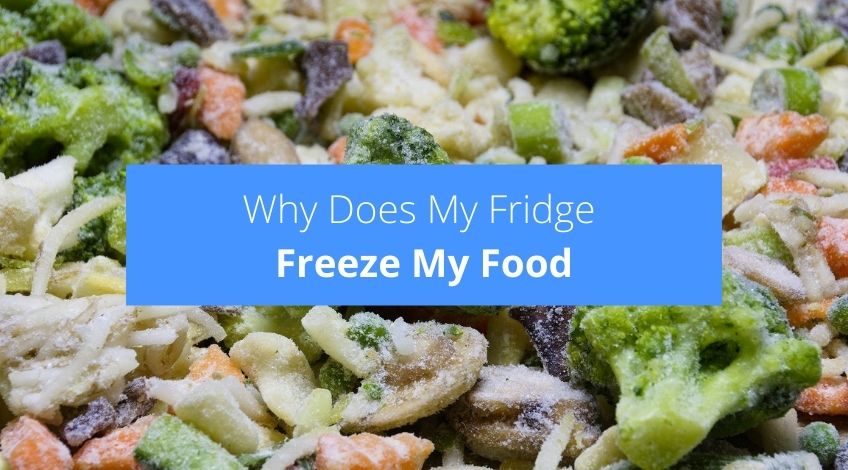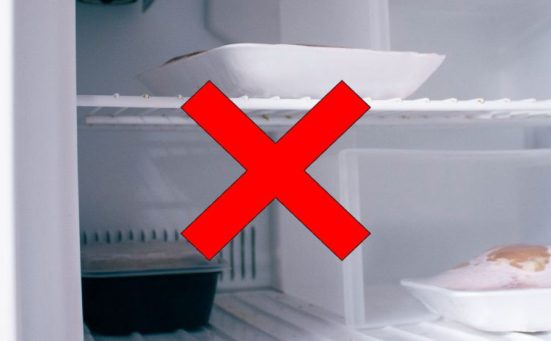
Why Does My Fridge Freeze My Food? (how to stop it & why it happens)
If you often find food has frozen in your refrigerator and you’re fed up with having to throw away spoiled foods, keep reading. There are often easy ways to prevent this annoying problem from occurring. In this article we look at the probable causes and fixes to why your fridge freezes your food.
What Causes Food To Freeze In The Fridge?
If you’re finding food freezing in your refrigerator there are a number of possible causes, let’s go through them and see how to solve them too.
Fridge Door Not Closed Properly
If the door of the fridge is not fully closed two things happen, firstly warm air enters the fridge which will condensate and turn to ice. This ice buildup prevents the evaporator from operating correctly which can cause the fridge to cool further creating freezing pockets. Also as the thermostat registers the warmer temperature inside the fridge it allows more cold air into the fridge which again causes ice pockets to form.
Fridge Door Seal Damaged
If the seal or gasket around the fridge door is damaged or has a buildup of dirt on it, it can allow warm air into the fridge which causes the exact same effect as having the door slightly open.
Blocked Air Vents
The air vents need a 2 inch clearance at all times to ensure a steady flow of air through the fridge. If one of these air vents is blocked or even partially blocked, the fridge senses an air flow issue and works harder to cool the fridge down. Thus sending more cold air into the fridge which can cause the fridge to freeze.
Thermostat Set At The Wrong Temperature
As the dial is so easy to access on many fridges, it’s easy to catch it and turn the dial accidentally. If you do catch it and set it on too cold a setting, the fridge will freeze.
Faulty Thermostat
When the thermostat is working correctly, it senses the temperature within the fridge and sends messages to the fridge’s working parts (condenser, compressor and evaporator) to maintain a level temperature which is determined by the dial. If the thermostat develops a fault, there is a breakdown in communication which can cause the fridge to freeze or warm up too much, neither of which is desirable.
To check whether the thermostat is working just wait until you hear the compressor is operating (you will hear a humming sound) then turn the thermometer dial until it clicks. The click shows the cooling system is shutting down which indicates the thermostat is working correctly. If you want to get technical, you can test the thermostat using a multimeter and checking for continuity. If there is no continuity, the thermostat needs replacing.
Check For Power Cool Function
Some refrigerators have a power cool function which basically bypasses the fridge’s temperature settings and sends bursts of cold air into the fridge to chill it in quick time. This is a useful feature to have especially if the fridge has been unused for some time or if you fill the fridge to its maximum capacity and want to get everything cold as soon as possible.
Check the control panel to see if the power cool icon is displayed. If it is, turn off the power cool via the instructions in your user guide.
Fridge Not Full Enough
If everything appears to be working correctly on your fridge, it could be that you don’t have enough contents stored in your fridge. What happens is the fridge sends out blasts of cold air, which are absorbed by the contents of the fridge, which in turn keep the mean temperature stable. With too few items in the fridge you run the risk of it freezing some of the contents.
If you don’t have enough food to fill your fridge try adding bottles of water to absorb some of that cold air.

Storing The Wrong Food Types In The Wrong Spot
There are certain foods that contain a high water content, foods like raw meat and leafy vegetables will always be the most vulnerable to freezing. If these are stored close to the air vents or damper, they are likely to freeze. Other cold spots are the bottom and back parts of the fridge.
The Fridge Is In The Wrong Position
Sometimes refrigerators are subject to external heat which can make the contents warmer than they should be. For instance, if the fridge is in direct sunlight, placed near a radiator, heating vent or cooking stove. The fridge then has to work harder to cool the contents down which can cause frost pockets in some places within the fridge.
This can also be the case if the ambient room temperature is too cold in the room the refrigerator is in. This could cause the contents of the fridge becoming too cold, which will freeze the food stored inside.
Faulty Air Damper
The air damper is basically a flap that bridges the connection between the fridge and the freezer. It opens and closes to regulate the amount of cold air that passes from the freezer to the fridge. If it gets stuck in the open position the fridge will fill with ice cold air and freeze everything inside.
Dirty Condenser Coils
As part of the cooling process, the condenser coils release the heat of the refrigerant to cool the fridge. If the condenser coils are covered in dirt, they cannot allow the heat to dissipate properly. Which causes the fridge to produce colder air which can cause freezing in the fridge.
Iced Up Evaporator
The evaporator is located at the back of the fridge and is covered with a plastic cover. If ice is visible on the outside of the plastic cover, it’s probably the evaporator that’s causing the problem. Defrost the fridge making sure to defrost the drain tube or remove any blockage from the drain tube. If you did have an ice buildup on the evaporator, it could be the defrost system has a fault.
Defrost System Fault
The defrost system consists of a defrost thermostat, defrost heater and a defrost control board. If any one of these develops a fault, the defrost system will stop operating. Check each part using a multimeter, we recommend leaving the control board to last as these barely ever develop a fault.
Faulty Thermistor
The function of the thermistor is to relay temperature readings to the fridge’s control board. The control board can then power up the evaporator fan and compressor to regulate the fridge’s temperature. If the thermistor is faulty, it will transmit a false reading which could, in turn, cause the fridge to freeze.
To check the thermistor using a multimeter look for resistance and continuity. The resistance should alter in line with the fridge temperature, if it isn’t and there’s no continuity, the thermistor is probably the cause of the frozen food in your fridge.
Safety Note
Before you start dismantling any part of your refrigerator, check to see if it is still under warranty. If it is, contact the manufacturer and explain the fault, they will then either advise you on exactly what to do, or send an engineer to make any repair. If your fridge is out of warranty, we would advise contacting a fully qualified electrical engineer unless you are 100% confident in your abilities.
The most important thing is to remain safe at all times. Before you dismantle any part of your refrigerator, disconnect the power supply first.
Frequently Asked Questions
If your fridge has suddenly started to freeze everything, it could be the thermostat is faulty. This can be checked using a multimeter and checking for continuity.
The most common cause of ice buildup is leaving the fridge door open for too long. Or a faulty door seal which has the same effect. Both allow warm air to enter the fridge which condenses into water and then freezes.
To prevent ice buildup in your refrigerator, check the door is closed properly, and that the door seal is undamaged. Also get in the habit of removing all that you need to prepare a meal from the fridge at the same time. This will reduce the amount of time the fridge is left open and reduce the entry time for warm air, which turns to ice once inside the fridge.
Also, follow us on Pinterest ...



